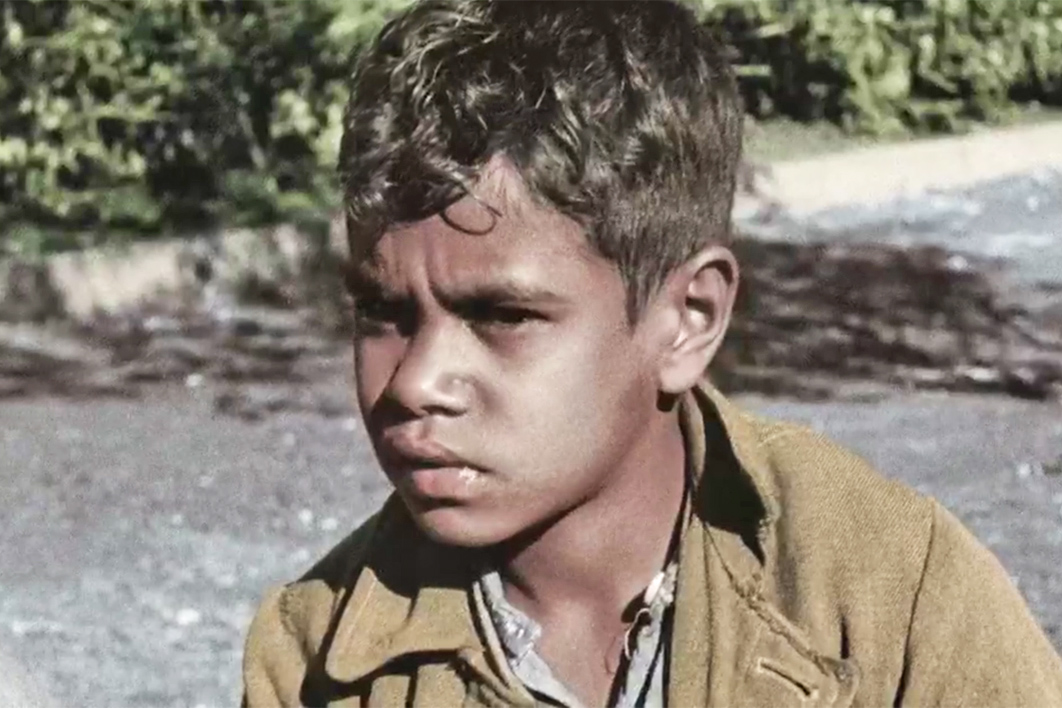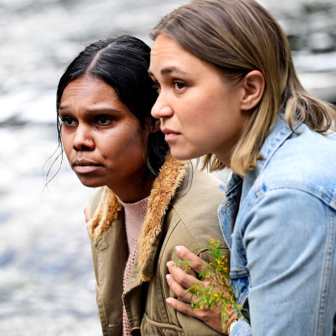A ring of spectators surrounds a busker performing a comedic rollerskating act in Sydney’s Prince Alfred Park. Working skilfully to hold his audience, he alternates between spins and pratfalls. It might be a scene from last weekend, though not quite. Aside from the onlookers’ Edwardian clothing, there are other signs of an era long gone.
The whole scenario is about decorum, and the lack of it. The bystanders — mostly male, in darks suits complete with waistcoats, polished shoes and boaters — demonstrate that this was a culture in which it was important to cut a dignified figure, even in the park. Only the busker, in his ill-proportioned brown suit and battered felt hat, gets to breach protocol. He has an outsize cigar stuck in his mouth, and as he turns, he lifts the back of his jacket to show a white hand emblazoned across the seat of the pants.
This footage, captured in 1896, is the earliest surviving film of life in Australia. It makes an appropriate starting point for the four-part SBS series Australia in Colour, not least because of the white hand, which acquires troubling connotations for a twenty-first-century audience. Inevitably, the simple photographic terms “colour” and “black and white” are now overlaid with other meanings.
In the introductory montage for the first episode, we see images of the first Melbourne tram, Douglas Mawson’s 1911 Antarctic expedition, children on a massive swing at an early fun park, Anzac troops returning, Vietnam troops cutting through jungle, girls dancing in a suburban backyard, boys riding goats down a country road. The voice of narrator Hugo Weaving is somewhat reminiscent of the patriarchal narrators of old newsreels: “This is the story of Australia transformed into colour for the first time… As the moving image is born, Australia unifies as a nation.”
Although, actually, it doesn’t. We also see images of Aboriginal children on a reserve, and of men in a desert community making fire. Then comes the stout matron of the mid-century middle class, “well dressed,” in the parlance of the times. “I don’t think at all that they should allow coloured races into Australia,” she says, with the righteousness of an entitlement that has never been challenged. We cut to film of a younger woman, carrying an infant, disembarking from a ship in a line of newly arrived immigrants from Europe. As the camera closes in on her face, it discovers no flicker of excitement or anticipation, only a look of apprehension.
It’s a striking juxtaposition indeed, a mere moment of screen time in the final program, but such moments are born of many dozens of hours of work in the archives and the editing studio. A series like this is a work of composition in which sound, image and narrative are woven together to create a whole that must amount to much more than the sum of its parts.
America in Color, the series on which it is based, was made for the Smithsonian network in 2017 and drew a generally favourable response. “You might not learn anything new about American history,” wrote the New York Times critic, “but the program might make you feel differently about that history.” It is the colour, essentially, that makes the difference. The work of colouring was done by Paris-based company Composite (also responsible for the colouring of the Australian series), which has devised a computer program for analysing greyscale tones and matching them with minutely subtle colour equivalences.
Clips of archival film that we may have seen before in black-and-white — scenes from the gold rush, suffragettes demonstrating, the opening of the Sydney Harbour Bridge in 1932, Don Bradman scoring in a cricket match — take on a new immediacy in colour. Those slightly hazy, two-dimensional figures become people like ourselves, with movements and expressions that draw us in to their world. The technique of leaking colour gradually across the picture is used to especially striking effect in crowd scenes.
Like the American series, the Australian version is a history of the moving image, merged with a chronological review of life and events in the twentieth century. Alec Morgan, who co-wrote and co-directed the Australian series in collaboration with Lisa Matthews, tells me that they intended to depart from the American model in some respects. Most significantly, they wanted to capture the dual meaning of “in colour” by countering the white Australian narrative with a parallel history of Aboriginal culture and politics, and by tracking the growth of multicultural Australia.
The risk here is that the series at times replicates the magazine style of early newsreels, where abrupt transitions from war zones to cricket matches to fashion parades are managed with a continuous stream of upbeat narrative that is essentially tone-deaf. Perhaps in order to avoid this tendency, a second series made by the Smithsonian is organised around themes (Wild West, Rise of the Mafia, Hollywood, America at Play, Titans of Industry).
Morgan recalls some discussion of this option in the early planning phases for the Australian series, but says it was never seriously considered as an alternative to the chronological structure. He and Matthews have done some fine work with the editing and composition of the episodes to counter the magazine effect, especially in the management of the Aboriginal history, which is stranded through each episode.
In the second episode (perhaps the strongest of the series) the Aboriginal side of the story is followed continuously rather than intermittently through the depression years. Footage taken in a remote mission shows the dormitories, with the children in a circle being trained in domestic tasks for their role as servants. But there are also escape routes from the misery in the burgeoning world of popular and travelling entertainments. Young Indigenous men got work in tent-boxing shows, or in the circus, where Con Colleano, his Aboriginal heritage masked with the persona of a Spanish toreador, became one of the leading highwire performers in the world.
Key phases of the movement for Indigenous citizenship rights and land rights are intercut with the colonial story of nation-building, but in such a way as to create a genuine weave of narratives, highlighting clashes and ironies.
Images of glitzy floats in city parades celebrating the 150th anniversary of the First Fleet as “white Australians unite in a wave of nationalism” are followed by a sustained account of the controversies over the re-enactment of the landing at Port Jackson. The script called for a staging of “the Eora retreat” and Aboriginal organisations around the Sydney area were asked to provide participants. When they all refused, twenty-six men were brought in from a reserve in western New South Wales and required to play the roles, under threat of having their rations cut.
Impressively, this series has been created with a fraction of the resources available to the producers at the Smithsonian, whose team included nine people in editing and post-production, seven editorial assistants, six people on sound, four on music and seven historians. To compensate for their much smaller team, the Australian program was created through institutional collaborations: Screen Australia, SBS and Stranger Than Fiction Films liaised with Arrow Media International and drew on expertise from the National Film and Sound Archive.
This is not gripping television. It is pedagogical in tone, and doesn’t have the edge of an investigative documentary or the zing of a satirical review. But it is certainly engaging. The subtlety of the process involved in releasing colour into the images is met by an equivalent level of finesse in narrative composition. •




